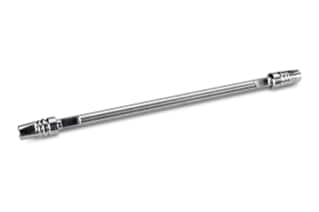
|
Chemistry |
C18 |
|
Separation Mode |
Reversed Phase |
|
Particle Substrate |
Hybrid |
|
pH Range Min |
1 pH |
|
pH Range Max |
12 pH |
|
Maximum Pressure |
18000 psi (1240 Bar) |
|
Endcapped |
Yes |
|
Silanol Activity |
Low |
|
Particle Shape |
Spherical |
|
Particle Size |
2.5 µm |
|
Endfitting Type |
Parker-style |
|
Pore Size |
130 Å |
|
Format |
Column |
|
Surface Area |
185 |
|
System |
UHPLC, UPLC |
|
Particle Technology |
BEH |
|
USP Classification |
L1 |
|
Inner Diameter |
2.1 mm |
|
Length |
150 mm |
|
Carbon Load |
18 % |
|
eCord |
Yes |
|
UNSPSC |
41115709 |
|
Brand |
XBridge |
|
Product Type |
Columns |
|
Units per Package |
1 pk |
XBridge BEH C18 XP Column, 130Å, 2.5 µm, 2.1 mm X 150 mm, 1/pk
Transfer methods easily and simply from HPLC to UPLC and from UPLC to HPLC using the XBridge BEH C18 XP Column. The lab equipment provides exceptional separation performance, robustness, and throughput for HPLC assays. It is designed to withstand higher pressures of 18,000 psi (1240 Bar) while delivering excellent results.
The XBridge BEH C18 sorbent present in the XBridge BEH C18 XP Column is a workhorse for UPLC method development and can be used over a wide operating range of mobile phase pH (1-12). The trifunctionally bonded C18 ligand in the sorbent offers a universal column for most HPLC separations, while providing you with the widest usable pH range, superior low pH stability, and ultra-low column bleed. The 2.5 µm eXtended Performance [XP] columns come packed in ultra-low dispersion hardware, enabling exceptional separation performance, robustness, and throughput for HPLC assays while enabling a seamless transition path toward UPLC adoption.
The XBridge BEH C18 XP Column helps you to maximize your productivity as it has been designed specifically for this purpose. Whether you aim to create a quality control method or to develop a cutting-edge LC/MS assay, the XBridge BEH C18 XP Column will be ideal lab equipment for either of these goals. As the column offers improved pH stability, it can provide extended column lifetimes. Using the analytical column, you can leverage assay ruggedness and enhance column reliability. Moreover, by maximizing particle efficiency, the XBridge BEH C18 XP Column enables you to deliver excellent peak shape and peak capacity.
The XBridge packing utilizes proprietary procedures for bonding and end-capping, resulting in ligand stability and chromatographic reproducibility at low pH. This is why the XBridge BEH C18 XP Column shows very little retention loss or peak shape degradation when compared to columns with conventional packing materials.
We recommend that you protect your XBridge BEH C18 XP Column by purchasing the XBridge BEH C18 XP VanGuard Cartridge, 130Å, 2.5 µm, 2.1 mm X 5 mm, 3/pk.
What Causes Peak Broadening In HPLC?
The sample injection volume is related to broadening of the sample zone in the first stage of column separation. Therefore, increasing the injection volume can result in peak broadening. In other words, the higher the ratio of strong solvent in the sample solvent, the greater the effects.